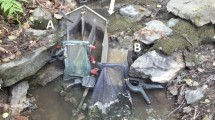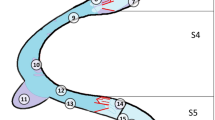Summary
We carried out an experimental field study in a Swedish stream in order to determine whether mobile predators enhance the drift of stream insects. We increased the density of nymphs of the predaceous perlid stonefly, Dinocras cephalotes, in an experimental section of a stream up to densities in another more densely populated part of the same stream. The drift of several benthic species increased significantly compared to a control section where D. cephalotes were rare. Experiments carried out in September showed a strongly elevated drift response in nymphs of the mayfly Baetis rhodani only, whereas May experiments resulted in increased drift in B. rhodani as well as the amphipod Gammarus pulex, the stonefly Leuctra fusca, chironomids, and the total number of drifting animals. In September, we found that the drift response of Baetis rhodani to predator disturbance was dependent on the size of mayfly nymphs; small nymphs appeared in greater numbers in the drift nets than did large nymphs. A subsequent laboratory analysis of drift lengths of B. rhodani nymphs supported the hypothesis that small nymphs travel in the drift for longer than do large nymphs, particularly in darkness. We suggest that morphological constraints in vision or swimming performance, or both, cause small nymphs to drift longer. In May, size-dependent drift was less obvious, probably because the size of the nymphs was considerably greater than in September.
Similar content being viewed by others
References
Allan JD (1978) Trout predation and the size composition of stream drift. Limnol Oceanogr 23:1231–1237
Allan JD (1984) The size composition of invertebrate drift in a Rocky Mountain stream. Oikos 43:68–76
Allan JD, Russek E (1985) The quantification of stream drift. Can J Fish Aquatic Sci 42:210–215
Allan JD, Flecker AS, McClintock NL (1986) Diel epibenthic activity in mayfly nymphs, and its noncordance with behavioral drift. Limnol Oceanogr 31:1057–1065
Andersson KA, Brönmark C, Herrmann J, Malmqvist B, Otto C, Sjöström P (1986) Presence of sculpins (Cottus gobio) reduces drift and activity of Gammarus pulex (Amphipoda). Hydrobiologia 133:209–215
Campbell RNB (1985) Comparison of the drift of live and dead Baetis nymphs in a weakening water current. Hydrobiologia 126:229–236
Chaston I (1972) Non-catastrophic invertebrate drift in lotic systems. In: Clarke I, Wootton RJ (eds) Essays in hydrobiology. Univ Exeter Press, pp 33–51
Cloarec A (1984) Development of the compound eyes of the water stick insect, Ranatra linearis. Physiol Entomol 9:253–262
Corkum LD, Clifford HF (1980) The importance of species associations and substrate types to behavioural drift. In: Flannagan JF, Marshall KE (eds) Advances in Ephemeroptera Biology. Plenum, New York, pp 331–341
Corkum LD, Pointing PJ (1979) Nymphal development of Baetis vagans McDunnough (Ephemeroptera: Baetidae) and drift habits of large nymphs. Can J Zool 57:2348–2354
Edmunds M (1974) Defence in animals. A survey of anti-predator defences. Longman Group Ltd, New York
Elliott JM (1967) Invertebrate drift in a Dartmoor stream. Arch Hydrobiol 63:202–237
Hurlbert SH (1984) Pseudoreplication and the design of ecological field experiments. Ecol Monogr 54:187–211
Keller A (1975) Die Drift und ihre ökologische Bedeutung. Experimentelle Untersuchungen an Ecdyonurus venosus (Fabr.) in einem Fließwassermodell. Schweiz Z Hydrol 37:295–331
Malmqvist B (1986) Drift of mayflies in response to disturbance by predacious stonefly nymphs. Proc 3rd Europ Congr Entomology, Nederlandse Entomologische Vereiniging, Amsterdam, pp 107–110
Malmqvist B, Sjöström P (1980) Prey size and feeding patterns in Dinocras cephalotes (Plecoptera). Oikos 35:311–316
Malmqvist B, Sjöström P (1984) The microdistribution of some lotic insect predators in relation to their prey and to abiotic factors. Freshwat Biol 14:649–656
Müller K (1974) Stream drift as a chronobiological phenomenon in running water ecosystems. Ann Rev Ecol Syst 5:309–323
Newman RM, Waters TF (1984) Size-selective predation on Gammarus pseudolimnaeus by trout and sculpins. Ecology 65:1535–1545
Otto C, Svensson BS (1980) The significance of case material selection for the survival of caddis larvae. J Anim Ecol 49:855–865
Peckarsky BL (1980) Predatory-prey interactions between stoneflies and mayflies: behavioural observations. Ecology 61:932–943
Peckarsky BL (1982) Aquatic predator-prey relations. BioScience 32:261–266
Ringler NH (1979) Selective fish predation by drift-feeding brown trout (Salmo trutta). J Fish Res Bd Can 36:392–403
Sih A (1984) The behavioral response race between predators and prey. Am Nat 123:143–150
Sjöström P (1985a) Territoriality in nymphs of Dinocras cephalotes (Plecoptera). Oikos 45:353–357
Sjöström P (1985b) Hunting behavior of the perlid stonefly nymph Dinocras cephalotes (Plecoptera) under two different light conditions. Anim Behav 33:534–540
Skinner WD (1985) Night-day drift patterns and the size of larvae of two aquatic insects. Hydrobiologia 124:283–285
Statzner B, Mogel R (1985) An example showing that drift net catches of stream mayflies (Baetis spp., Ephemeroptera, Insecta) do not increase during periods of higher substrate surface densities of the larvae. Verh Internat Verein Limnol 22:3238–3243
Statzner B, Dejoux C, Elouard J-M (1984) Field experiments on the relationship between drift and benthic densities of aquatic insects in tropical streams (Ivory Coast). Revue Hydrobiolique Tropical 17:319–334
Stein RA, Magnuson JJ (1976) Behavioral response of crayfish to a fish predator. Ecology 57:751–761
Walton EO (1978) Substrate attachment by drifting aquatic insect larvae. Ecology 59:1023–1030
Walton EO (1980) Invertebrate drift from predator — prey associations. Ecology 61:1486–1497
Waters TF (1972) The drift of stream insects. Ann Rev Entomol 17:253–272
Wiley MJ, Kohler SL (1981) An assessment of biological interactions in an epilithic stream community using time-lapse cinematography. Hydrobiologia 78:183–188
Wiley MJ, Kohler SL (1984) Behavioral adaptations of aquatic insects. In: Resh VH, Rosenberg DM (eds) The ecology of aquatic insects. Praeger, New York, pp 101–133
Wotton RS (1986) The use of silk life-lines by larvae of Simulium noelleri (Diptera). Aquatic Insects 8:255–261
Author information
Authors and Affiliations
Rights and permissions
About this article
Cite this article
Malmqvist, B., Sjöström, P. Stream drift as a consequence of disturbance by invertebrate predators. Oecologia 74, 396–403 (1987). https://doi.org/10.1007/BF00378936
Received:
Issue Date:
DOI: https://doi.org/10.1007/BF00378936




